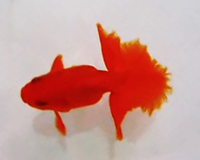Tosakin
From Wikipedia, the free encyclopedia
| Tosakin goldfish |
|---|
 |
| Country of origin |
| Japan |
| Type |
| Fantailed |
| Breed standards |
| Johnson & Hess
(see references) |
The Tosakin or curly fantail goldfish is a very distinctive breed of goldfish with a large undivided tail fin that spreads out horizontally (like a fan) behind the fish. It was developed in Japan, and is rarely seen in other countries.[1] It is also known as the peacock tail goldfish, and may have originally been developed from the hardier ryukins.[2]
[edit]Description
Although it has a body shaped like that of the Ryukin, its undivided tail fin opens and spreads so flat and wide horizontally causing the front ends to flip under at the front once and even twice. The Tosakin is a weak and clumsy swimmer (attributed to inbreeding), thus requires special care and has to be kept in shallow water with no current. It is thought to be very susceptible to water chemistry changes. A year-old Tosakin is regarded as the weakest.[1][3]
The Tosakin is best viewed from above. Seen from above, with its pointed head and deep, round trunk, the tail is obviously a flat half circle that curls under once or twice at the front edge. Tosakins come in red, red and white, iron black and calico colors, and grows up to medium size. Breeder Tosakins are described to be quite slow to spawn but can be artificially spawned if necessary.[1]
[edit]Origins
The Tosakins were first developed by a lower-ranking samurai in the Tosa fief (now Kochi Prefecture), in Shikoku, Japan and probably did not reach other parts of Japan until the mid-twentieth century.[1]
U.S. air attacks on Kochi during World War II in 1945 and an earthquake in 1946 were believed to have wiped out the Tosakin variety. However, Mr. Hiroe Tamura(田村広衛), a Japanese hobbyist who had lost all of his fish, scoured the area and found six fish (2 breeders and 4 two-year olds) at a local restaurant called Kyousuirou (鏡水楼). He managed to trade a large bottle of shouchuu (焼酎)(Japanese sweet-potato vodka) for the fish, and was able to successfully revive the Tosakins in Kochi. In 1969, the Japanese government declared the Tosakin aTennen Kinenbutsu(天然記念物) or Natural Treasure of Kochi Prefecture. In 1971 the breed had reached Tokyo, where a small group of young and avid enthusiasts painstakingly propagated and popularized the variety. The Tosakin Preservation Society (トサキン保存会) was founded a few years later in Aichi prefecture (愛知県).[1]
